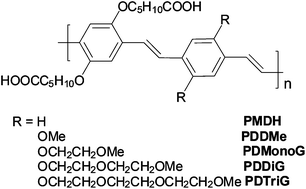Water-soluble anionic poly(p-phenylene vinylenes) with high luminescence†
Abstract
Conjugated photoluminescent polymers are becoming materials of choice in an ever-growing range of applications, including photovoltaics, flexible displays, chemical and biological sensors. Increasing processability and adding functionality to these materials are of crucial importance. We report here the synthesis and properties of a series of functionalized poly(p-phenylene vinylene) (PPV) substituted with carboxylic acid groups and polar ethylene glycol side chains of varying lengths. We demonstrate the solubility of these polymers in aqueous solutions, which is significant at neutral and high pH values and increases as the length of ethylene glycol side chains is increased. Importantly, a high photoluminescence quantum yield is maintained. To the best of our knowledge, this is the first report of the synthesis of PPV functionalised with both carboxylic acid and ethylene glycol functionalities, thus adding to the limited library of available PPVs soluble in both organic and aqueous based solutions. Further, we report on optical and electrochemical properties of these polymers. This is the first paper that investigates the effect of systematically substituting carboxylic acid functionalized PPV with polar ethylene glycol side chains on the solubility, optical and electrochemical properties.


 Please wait while we load your content...
Please wait while we load your content...